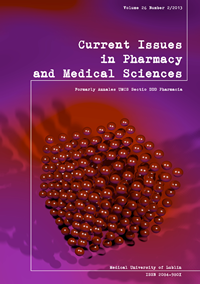Determination of vitamin C and selected low molecular weight organic acids in aqueous extract of mulberry leaves used as dietary supplements
DOI:
https://doi.org/10.12923/j.2084-980X/26.2/a.22Słowa kluczowe:
dietary supplements, micronutrients, enzymatic methods, dicarboxylic acidsAbstrakt
Some scientific reports indicate the possibility of using different parts of mulberry (Morus alba L.) as the source of bioactive compounds to prevent type 2 diabetes. The aim of the present study was to determine the content of vit. C (ascorbic acid) and four different low molecular weight organic acids (citric, malic, oxalic, tartaric) in aqueous extracts made from the two kinds of dietary supplements: 1) containing 100% of M. alba leaf (coded as SICOM) and 2) containing admixture of mulberry leaves and other medicinal herbs (MUCOM). The content of vitamin C was determined by Tillmans method, oxalic acid - by manganometric titration, tartaric acid - by colorimetric procedure, citric and malic acid by enzymatic assays. Total acidity (expressed as content of citric acid) was determined by potentiometric titration. The average content of vitamin C in aqueous extracts of SICOM was found as 0.30 mg/100 mL, while the concentration of individual acids were found to be in range: oxalic 12.66-32.34 mg/100 mL, tartaric 14.18-26.29 mg/100 mL, citric 9.74-19.99 mg/100 mL, malic 4.52-5.23 mg/100 mL. Aqueous extracts prepared from SICOM containing coarse powder of mulberry leaves indicated the highest content of vitamin C and tartaric acid, respectively, 0.34 and 26.29 mg/100 mL, while the content of citric acid was the lowest (9.74 mg/100 mL). The results of chemometric analysis with PCA method showed that measured profile of vitamin C and the four low molecular weight organic acids could be used for superior differentiation of aqueous extracts obtained from SICOM and MUCOM dietary supplements, as well as enabling to distinguish such extracts prepared from the fine and coarse powdered mulberry leaves in these supplements.
Bibliografia
1. Bryland A. et al.: Citrate treatment reduces endothelial death and inflammation under hyperglycaemic conditions. Diab. Vasc. Dis. Res., 9(1), 42, 2012.
2. Butt M.S. et al.: Morus alba L. nature’s functional tonic. Trends Food Sci. Technol.,19(10), 505, 2008.
3. Deepa M. et al.: Purified mulberry leaf lectin (MLL) induces apoptosis and cell arrest in human breast cancer and colon cancer cells. Chem. Biol. Interact., 200(1), 38, 2012.
4. Ercisli S., Orhan E.: Chemical composition of white (Morus alba), red (Morus rubra) and black (Morus nigra) mulberry fruits. Food Chem., 103(4), 1380, 2007.
5. Geng C.A. et al.: Mulberrofuran G and isomulberrofuran G from Morus alba L.: anti-hepatitis B virus activity and mass spectrometric fragmentation. J. Agric. Food Chem., 60(33), 8197, 2012.
6. Gundogdu M. et al.: Determination of fruit chemical properties of Morus nigra L., Morus alba L. and Morus rubra L. by HPLC. Scientia Horticulturae, 132, 37, 2011.
7. Hunyadi A. et al. : Chlorogenic acid and rutin play a major role in the in vivo anti-diabetic activity of Morus alba leaf extract on type II diabetic rats, PLoS ONE 7(11), e50619. doi:10.1371/journal.pone.0050619, 2012.
8. Imran M. et al.: Chemical composition and antioxidant activity of certain Morus species. J. Zhejiang Univ.-Sci. B (Biomed. & Biotechnol.),11(12), 973, 2010.
9. Koyuncu F.: Organic acid composition of native black mulberry fruit. Chem. Natural Compounds, 40(4), 367, 2004.
10. Lee Y.J. et al.: Hypotensive, hypolipidemic, and vascular protective effects of Morus alba L. in rats fed an atherogenic diet. Am. J. Chin. Med., 39(1), 39, 2011.
11. Mahmood T. et al.: Compositional variation in vugars and organic acids at different maturity stages in selected small fruits from Pakistan. Int. J. Mol. Sci., 13(2), 1380, 2012.
12. Pawłowska A.M., Oleszek W., Braca A.: Quasi-quantitative analyses of flavonoids of Morus nigra L. and Morus alba L. (Moraceae) fruits. J. Agric. Food Chem., 56(9), 3377, 2008.
13. Sakurai N. et al.: Vasorelaxant activity of caffeic acid derivatives from Cichorium intybus and Equisetum arvense. Yakugaku Zasshi, 123(7), 593, 2003.
14. Sridhar S.B. et al.: Preclinical evaluation of the antidiabetic effect of Eugenia jamboana seed powder in streptozotocin – diabetic rats. Braz. J. Med. Bio. Res., 3(38), 463, 2005.
15. Vasant R.A., Narasimhhacharya A.V.: Limonia fruit as a food supplement to regulate fluoride-induced hyperglycaemia and hyperlipidemia. J. Sci. Food. Agric., 93(2), 422, 2013.
Pobrania
Opublikowane
Numer
Dział
Licencja
Prawa autorskie (c) 2013 Autorzy

Praca jest udostępniana na licencji Creative Commons Attribution-NonCommercial-NoDerivatives 3.0 Unported License.


